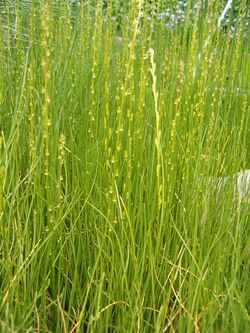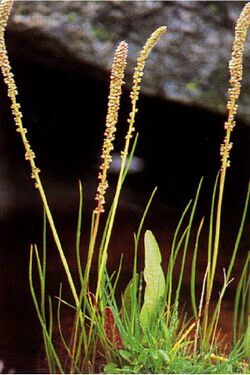Biology:Juncaginaceae
| Juncaginaceae | |
|---|---|

| |
| Triglochin palustris | |
| Scientific classification | |
| Kingdom: | Plantae |
| Clade: | Tracheophytes |
| Clade: | Angiosperms |
| Clade: | Monocots |
| Order: | Alismatales |
| Family: | Juncaginaceae Rich.[1] |
| Genera | |
Juncaginaceae is a family of flowering plants, recognized by most taxonomists for the past few decades. It is also known as the arrowgrass family. It includes 3 genera with a total of 34 known species (Christenhusz & Byng 2016 [2]).
The APG II system, of 2003 (unchanged from the APG system, of 1998), also recognizes such a family and places it in the order Alismatales, in the clade monocots. The species are found in cold or temperate regions in both the Northern and Southern Hemisphere. However APG IV (2016) removed the genus Maundia due to its non-exclusive relationship, and elevated it to the monogeneric family Maundiaceae.
Description
Juncaginaceae are marsh or aquatic herbs with linear, sheathing basal leaves. The flowers are small and green in erect spikes or racemes. The flower parts come in threes, but the carpels are either 3 or 6, joined to a superior ovary. The fruit is a capsule.[3] Example arrowgrasses Triglochin include the Marsh Arrowgrass (Triglochin palustris), the Sea Arrowgrass (Triglochin maritima), and also other species like Triglochin trichophora, Triglochin striata and Triglochin mucronata.
| Juncaginaceae |
| ||||||||||||||||||
Taxonomy
The genus Maundia was placed within the family Juncaginaceae by the APG II. The newer APG III version (2009), though, suggested it may be necessary to split Maundia off into its own monogeneric family, Maundiaceae,[1] supported by the non-exclusive relationship of the genus to Juncaginaceae.[4] This was achieved in the APG IV (2016), leaving only four genera in Juncaginaceae.[5]
References
- ↑ 1.0 1.1 Angiosperm Phylogeny Group (2009). "An update of the Angiosperm Phylogeny Group classification for the orders and families of flowering plants: APG III". Botanical Journal of the Linnean Society 161 (2): 105–121. doi:10.1111/j.1095-8339.2009.00996.x.
- ↑ Christenhusz, M. J. M.; Byng, J. W. (2016). "The number of known plants species in the world and its annual increase". Phytotaxa 261 (3): 201–217. doi:10.11646/phytotaxa.261.3.1. http://biotaxa.org/Phytotaxa/article/download/phytotaxa.261.3.1/20598.
- ↑ Rose, Francis (2006). The Wild Flower Key. Frederick Warne & Co. pp. 486–487. ISBN 978-0-7232-5175-0.
- ↑ Les & Tippery 2013.
- ↑ APG IV 2016.
Bibliography
- Angiosperm Phylogeny Group (2016). "An update of the Angiosperm Phylogeny Group classification for the orders and families of flowering plants: APG IV". Botanical Journal of the Linnean Society 181 (1): 1–20. doi:10.1111/boj.12385.
- Christenhusz, Maarten J.M.; Vorontsova, Maria S.; Fay, Michael F.; Chase, Mark W. (August 2015), "Results from an online survey of family delimitation in angiosperms and ferns: recommendations to the Angiosperm Phylogeny Group for thorny problems in plant classification", Botanical Journal of the Linnean Society 178 (4): 501–528, doi:10.1111/boj.12285
- Les, Donald H; Tippery, Nicholas P, In time and with water ... the systematics of alismatid monocotyledons, pp. 118–164, http://hydrodictyon.eeb.uconn.edu/people/les/Manuscript_Files/Early_Events.pdf, in (Wilkin Mayo)
- Wilkin, Paul; Mayo, Simon J, eds (2013). Early events in monocot evolution. Cambridge: Cambridge University Press. ISBN 978-1-107-01276-9. https://books.google.com/books?id=sEfKwaRHQj4C. Retrieved 9 December 2015.
- Von Mering, S; Kadereit, JW. Phylogeny, Systematics, and Recircumscription of Juncaginaceae – A Cosmopolitan Wetland Family. pp. 55–79. http://juncaginaceae.myspecies.info/sites/juncaginaceae.myspecies.info/files/von%20Mering%20%26%20Kadereit_2010_phylogeny_Juncaginaceae.pdf., in (Seberg et al 2010)
- Seberg, Ole; Petersen, Gitte; Barfod, Anders et al., eds (2010). Diversity, phylogeny, and evolution in the Monocotyledons: proceedings of the Fourth International Conference on the Comparative Biology of the Monocotyledons and the Fifth International Symposium on Grass Systematics and Evolution. Århus: Aarhus University Press. ISBN 978-87-7934-398-6. http://en.unipress.dk/udgivelser/d/diversity,-phylogeny,-and-evolution-in-the-monocotyledons/.
External links
- Juncaginaceae in L. Watson and M.J. Dallwitz (1992 onwards). The families of flowering plants: descriptions, illustrations, identification, information retrieval. Version: 9 March 2006. http://delta-intkey.com
- Juncaginaceae in the Flora of North America
- NCBI Taxonomy browser
- links at CSDL, Texas
- Juncaginaceae of Mongolia in FloraGREIF
Wikidata ☰ Q862544 entry
 |


